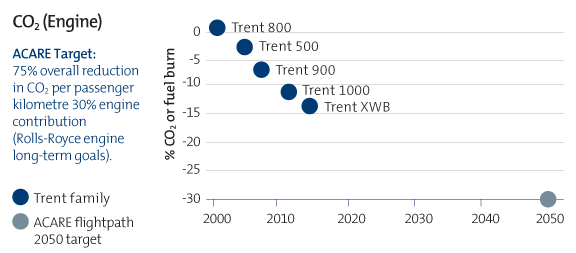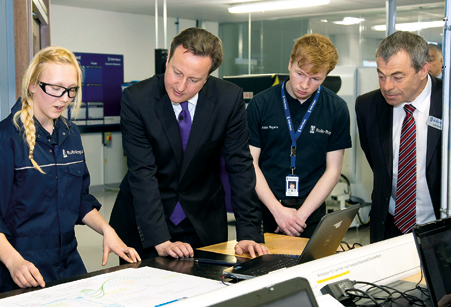Our people
Our culture fosters innovation, collaboration
and continuous improvement. Developing
strong people management and leadership
skills alongside our technical expertise helps
ensure that our employees are engaged and
understand the wider role they play in the
Group’s success. We work actively to
attract young people to Science, Technology,
Engineering and Mathematics (STEM)
subjects.
Content and figures do not include Rolls-Royce
Power Systems AG, unless indicated.
In 2013, we recruited 2,530 experienced
professionals to support the growth of our
business. Our graduate programme is
expanding, we recruited 379 graduates
through our global programmes, an increase
of 21 per cent from 2012. Our graduate
population is becoming more representative
of the diverse and global company we are
working in, with this year’s graduates
representing 32 nationalities and coming
from 97 universities. Our apprenticeship
programme has been running for over 100
years. At any one time we have over 1,000
apprentices around the world.
Average number of employees
| Average number of employees |
2012 |
2013 |
* |
| By region |
|
|
|
| United Kingdom |
22,800 |
24,800 |
|
| Rest of the world |
20,000 |
30,400 |
|
| Total |
42,800 |
55,200 |
|
| By sector |
|
|
|
| Civil aerospace |
21,500 |
23,400 |
|
| Defence aerospace |
7,800 |
7,900 |
|
| Marine |
8,800 |
9,200 |
|
| Energy |
3,700 |
4,000 |
|
| Power Systems |
1,000 |
10,700 |
|
| Total |
42,800 |
55,200 |
|
We retained our title as ‘The most popular
graduate recruiter – Engineering, Designs
and Manufacture’ in the UK TARGETjobs
Awards for the fourth year running. Our
position has also risen in the ‘Times Top 100
Graduate Employers’ rankings and in the
‘Guardian UK 300’ survey.
Employee involvement
Employee engagement is critical to our
success. We use a variety of channels to
communicate with our employees. We have
well-established frameworks for managing
employee and trade union/employee
representative participation which include
formal information and consultation
arrangements. Our incentive schemes and
all-employee share plans make sure that
every employee has the opportunity to share
in our success. We encourage our employees
to improve their knowledge and enhance
their careers by providing meaningful
training and development. In 2013, we
supported 49,600 employees, customers and
suppliers through our learning management
system. Learning investment for 2013 was
£39.7 million and a total of 272,000 training
course completions were delivered during
the year.
Human rights
Our human rights policy sets out our
commitment to respect the human rights
of our employees through core labour
standards regarding employee involvement,
diversity and equality, pay and benefits,
working hours, forced labour and child
labour. We set equivalent standards for our
supply chain through our Supplier Code
of Conduct.
Diversity and inclusion
A diverse workforce will help ensure our
continued success as a global business and
contribute towards a better future. We
continue to face challenges in increasing
diversity across the organisation and are
working with our leadership teams to raise
awareness of the need for change. Over
recent years we have seen increased levels
of diversity in both our early career pipeline
and high potential pool, with females
making up 26 per cent of our UK graduate
intake in 2013 and 29 per cent of our
graduate intake into countries outside the
UK. Females are 24 per cent of our high
potential population as compared to 15
per cent of our general population.
This year, Rolls-Royce sponsored the UK
Female Undergraduate of the Year 2013
awards. The winner, Ella Jakubowska,
accepted a place on our Customer
Management Graduate Programme.
This table contains information about diversity and inclusion
Headcount by gender* |
Full-time equivalents
at 31 December 2013 |
| Male |
46,975 |
| Female |
8,225 |
| Total |
55,200 |
This table contains information about diversity and inclusion
| Senior managers by gender* |
|
| Male |
188 |
| Female |
11 |
This table contains information about diversity and inclusion
| Board directors by gender |
|
| Male |
10 |
| Female |
2 |
We give full and fair consideration to
applications for employment made by
disabled people and also support employees
who become disabled during employment,
helping them make the best use of their
skills and potential.
Community investment
We are committed to conducting business to
the highest standards and building positive
relationships within the communities where
we operate. In 2013, our total contribution
was £8 million. We actively work with
schools and universities to increase interest
and encourage diversity amongst those
taking STEM subjects, and to broaden the
career aspirations of individuals from
under-represented groups.
Working with governments
National governments are often our
customers and we aim to build strategic
relationships with governments in our
key markets.
National governments and the EU also set
the legislative and policy framework for
doing business and they are a potential
source of funding and support for research
and technology (R&T), R&D, manufacturing,
education and training initiatives, as well as
for certain capital projects.
We engage in dialogue to align our own
business needs with the political, social,
economic, industrial and commercial
requirements of national governments
and the EU.
In 2013, we have worked with the UK
Government on the development and
implementation of the Aerospace Growth
Partnership; in EU Affairs, we have
focused on the Horizon 2020 EU funding
programme; and in North America we
focused on defence appropriations and
policy issues.
Globally, we are members of national
industry bodies and trade associations that
represent our sector and Group interests.
In the UK we are members of the
Confederation of British Industry (CBI) and
AeroSpace, Defence and Security (ADS); in
North America the Aerospace Industries
Association, Organisation for International
Investment and the US Chamber of
Commerce; in Brussels on EU affairs we
belong to The AeroSpace and Defence
Industries Association of Europe (ASD) and
EU Turbines, amongst others; and globally
we are members of local Chambers of
Commerce in our countries of operation.
Rolls-Royce does not make corporate
contributions or donations to political
parties or to any organisations, think-tanks,
academic institutions or charities closely
associated to a political party or cause, as
outlined in our Global Code of Conduct.
Back to top





